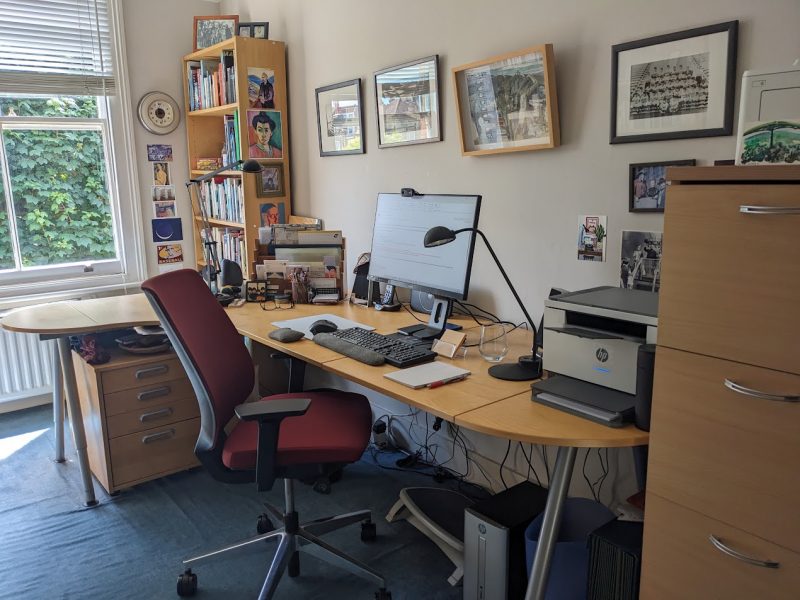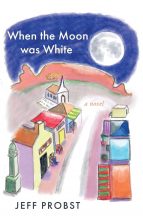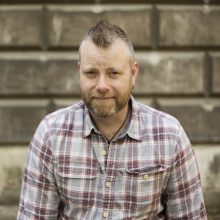When the Moon was White by Jeff Probst
What led you into writing?
I write about whatever is happening in my life. In the past I wrote about my experience of the late Sixties, then I wrote about an American teaching English in London, and my first novel was a thinly veiled autobiography. For my latest novel, I looked up at the moon one night and thought how horrible it would be if it was defaced.
How does a typical day look?
I spent nine years writing my latest novel in my warm wordy encampment; now I spend the mornings promoting it, primarily online.
In what ways do your characters test your abilities?
As I am all of them to some degree, I had to decide which characteristics to give to which characters, and what about them wasn’t me. If I was a rock band, I would have three of the main characters in it, but not the fourth.
What’s your setup?
I work at my PC on my IKEA desk and look out the window to the sycamore tree in the back garden. There is warmth if I need it, and it is quiet.

What lasting effects have your favourite authors had on your writing and style?
Jack Kerouac, his neologisms and pyrotechnic energy
Hermann Hesse, his gentle internal meanderings
Laurie Lee, the exquisite beauty of his poetic prose
HD Thoreau, his directness, honesty and simplicity
Kurt Vonnegut, his genre-bending mix of science fiction, social commentary, absurdity, autobiography and philosophy
What do you do for inspiration?
I walk around the neighbourhood and into Alexandra Park and Queen’s Wood, thinking, listening to the birds or sometimes to music.
What repeating themes do you find yourself pulling into your stories?
My mnemonic to remember the themes is LIGHT:
Loneliness, Intimacy, Guilt, Honesty, Trust – with wordplay stitching these together.
How do you wind down?
Listening to Sixties rock music, playing chess online, cleaning the flat.
What sort of challenges do you regularly overcome while designing your world/setting?
I wanted the town I created to ring true to the nature of the times. The facts about the moon needed to be correct. The way I changed the 1967 Surveyor moon rocket mission needed to be technically plausible, so I consulted physicists and engineers. The facts of the colour-creation scene are based on what I learned from artists and colour scientists.
What are you reading at the moment?
Don Quixote – the graphic novel, The Biggest Bluff (a book on poker), archie and mehitabel, Cunk on Everything, The Analog Sea Review, Treat Your Own Neck, and all sorts of online articles, often via the Arts&Letters Daily site.
What’s the most useful advice you could give to an aspiring author?
Stay true to your own unique voice. Only you can write what you’ve written. As Zadie Smith said, ‘An author’s literary style is about conveying the only possible expression of a particular human consciousness.” But day-to-day reality is more important than writing about it.
Tell us about the book you’re promoting.
To quote the blurb on the back of my current novel, ‘When the Moon was White’:
Many stories have been written about the sixties, the decade of the Moon Race, and this literary novel, serious at its core but whimsical in its prose, takes a unique look at the fate of the moon during that decade.
Samuel Thwaite is looking for a place to put his stamp on. He chooses Goodmews, a laid-back American town known for its bright moon, and persuades the residents to let him establish the world’s first Moon Centre.
NASA funds the Centre, and while Goodmews thrives, Thwaite becomes obsessed with achieving something grander, that will last forever. He enlists a rogue NASA engineer, and together they develop a plan. They will use a moon rocket to spread paint over a giant crater so the moon will no longer look white.
By chance, Banno, the Moon Centre guard, discovers the plan. He knows he should tell someone, but he has signed NASA’s oath of secrecy, and prides himself on keeping his word.
👋 Hi! I run Author Interviews
As a new writer I found myself itching to contribute to a thriving, creative community, so I made Author Interviews and I've met loads of wonderful people in the process. You can buy my debut fantasy RINGLANDER: THE PATH AND THE WAY from Amazon.





